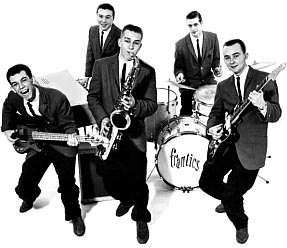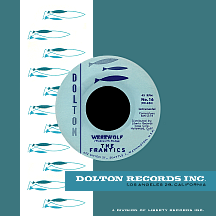THE FRANTICS
Werewolf
Seventh-graders Ron Petersen and Charles Schoning of Seattle didn't dream about being in a band for very long...they just went ahead and formed one. Never mind that Ron was still in the process of learning guitar chords and Chuck's instrument of choice was the accordion; they practiced relentlessly for the better part of a year and in 1956, as eighth grade grew closer, found two friends to round out the roster. Gary Gerke played organ while Joel Goodman, proud possessor of a driver's license (and a car!), served dual duty as drummer and, once they secured some gigs, driver. As The Four Frantics, they made their public debut in a talent show at Jane Addams Junior High. With Gerke's exit the following year, Schoning switched to keyboards, bassist Jim Manolides and saxophonist Bob Hosko were added and the more concisely-named Frantics became full-fledged forerunners of Sea-Town's rock and roll scene.
Later, Don Fulton replaced Goodman and the lineup was set for the band's most successful stretch. Circa-'58 competition came from a pair of slightly more seasoned R&B-based bands, both led by former Garfield High School students: Dave Lewis and his combo, who opened for many of the era's top-selling rock and roll acts, and The Playboys, featuring soon-to-be hitmaking singer Ron Holden. The Frantics made up for their rougher, less-experienced sound by taking a more aggressive self-promotional approach. On weekends they could be found in local community centers, lodges, theaters or playing at various schools, refining the act and landing opening spots on tour stops for artists like Jimmy Clanton and Gene Vincent. In February 1959 they opened for Bobby Darin at Parker's Ballroom in North Seattle; impressed by the quartet, Darin asked if they would meet him the following day at a local studio. They provided backing for two songs, "Dream Lover" and "Bullmoose," though these versions weren't used for the final release, a million-selling smash just a few months later.

Making a connection with Art Simpson, the nighttime deejay at AM 1300 KOL, Seattle's leading top 40 station, led to another studio gig in early 1959 backing Olympia, Washington vocal trio The Fleetwoods on a demo of "Come Softly to Me," a re-recording of which would soon be the nation's number one hit and a spectacular beginning for Bob Reisdorff's Dolton, a local independent label. Bob took a liking to the Frantics and signed them, scheduling "Straight Flush," a midtempo sax shuffler, for the label's second release. KOL led the way on the track, ranking it top ten in April on the station's weekly survey; airplay and sales in numerous markets got the disc into Billboard's Hot 100 for a few weeks in May and June. The Frantics had beaten the odds with a chart single on the first try. Its follow-up, a more brass-infused number called "Fog Cutter," was another big one on KOL and briefly made the national chart in September '59.
The band's spine-tingling, Halloweenish classic came next, its premise based on superstitious folklore: "Werewolf" begins with an eerie spoken preface by Reisdorff: 'Even a man whose heart is pure, and says his prayers at night, may change to a wolf when the wolf-bane blooms, the full moon shining bright!' The guitar-heavy arrangement perfectly conjures images of its title monster-of-the-moors, complete with scary growling effects and a final chilling wolf howl. While most of the Frantics' songs were written together by the band's members, this nerve-wracking number came from the pens of Terry Wadsworth and Gary Hodge, Northwest singer-songwriters with their own separate record releases (the latter on Dolton). Issued in October, the single met with resistance for a number of reasons (conflicting religious beliefs or a fear that the song might be too frightening for children), leading to a second release, replacing the original flip, "Checkerboard," with an edited B side, "No Werewolf," that removed the spoken intro and all sound effects, giving station programmers an option to play either side based on individual preference. Either way, it became the group's highest-ranked single, making KOL's top five during February 1960 before reaching number 83 on Billboard the following month, helped by airplay at many outlets, particularly in western U.S. locations.
Hopes ran high for the next band-penned single, "The Whip" (its sound effects all-too-obvious), but besides getting a little airplay on KOL, it went nowhere. The group supplied instrumental backing for more singers, including Little Bill ("Sweet Cucumber") and Dolton's original chart-topping trio on "I Love You So" (credited as The Fleetwoods with the Frantics). Meanwhile, Reisdorff, who initially resisted signing a second instrumental group, relented and picked up The Ventures...and they had a runaway smash with "Walk - Don't Run" on Dolton in the fall of '60, trouncing any momentum the Frantics had while building a multi-million-selling track record with a string of hit singles and albums spanning the entire decade.
Ron, Chuck and the once-thriving Frantics had two more single releases, "One Minute of Flamenco (For Two Minutes)" (a few Spanish lyrics thrown in) and "San Antonio Rose," before their time with Dolton was done. Three singles appeared over the next year on Seattle labels Seafair Bolo and Seafair before the band splintered; Petersen popped up on Jerden Records in '64 with a new band and a remake of Ray Sharpe's "Linda Lou" credited to Ron Petersen and the Accents. Chuck Schoning continued under The Frantics' name with a rapidly-changing lineup of musicians. Eventually they peddled their wares in San Jose, California, gigging for awhile before calling it quits in 1966. Later members Jerry Miller, Don Stevenson and Bob Mosley went to San Francisco and joined Moby Grape, another notoriously short-lived band.


